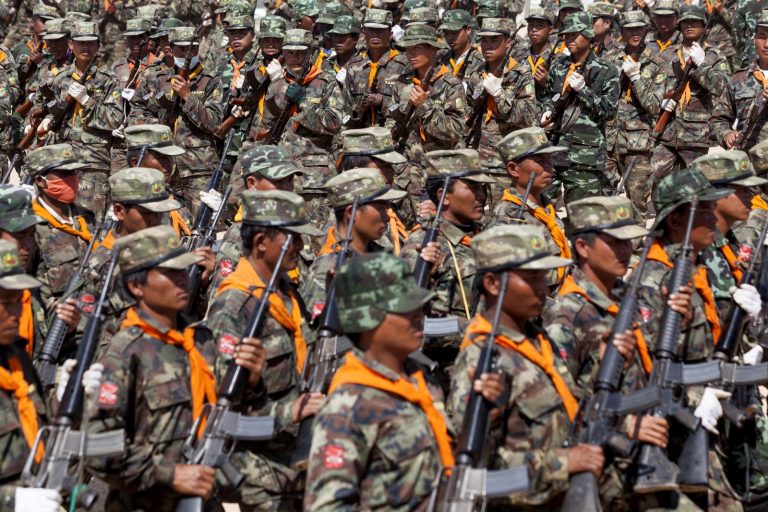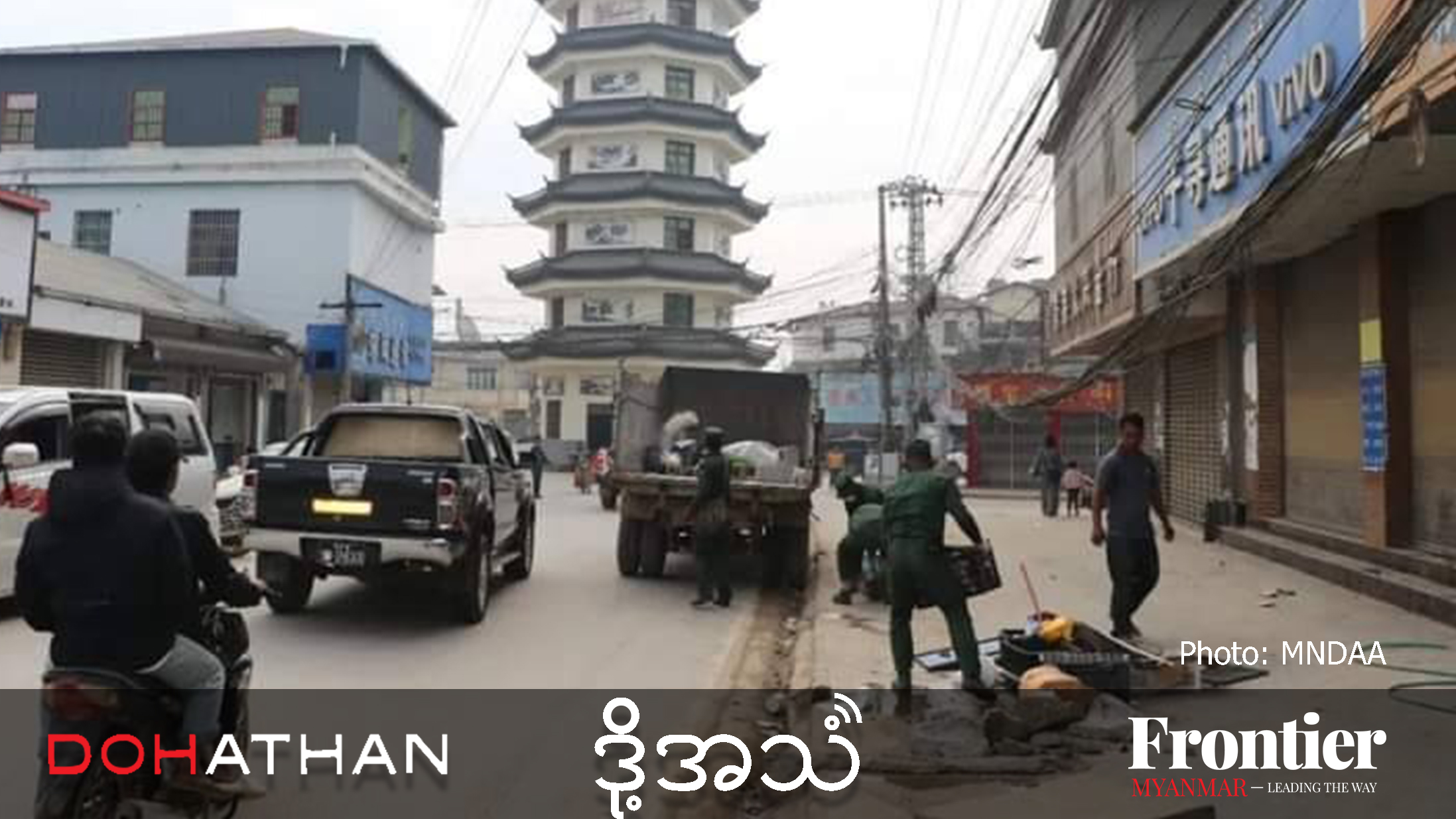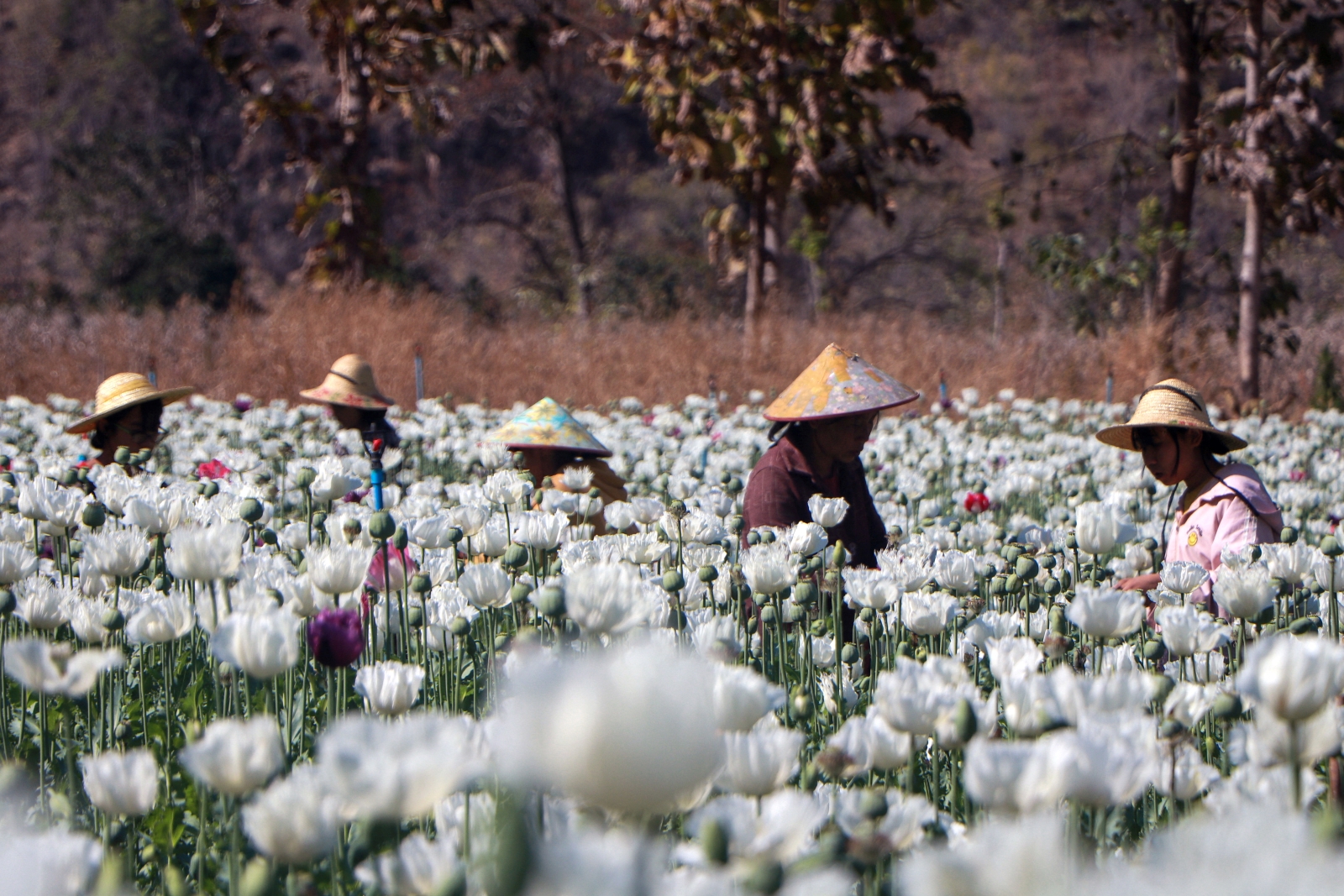Tea cultivators in Shan are struggling to recruit workers due to low wages as well as conflict, while a lack of investment and infrastructure is inhibiting exports.
By FRONTIER
“When you’re born into a Ta’ang family, you have to be a tea grower,” said Ko Win Naung, 40, who runs a tea plantation in northern Shan State’s Palaung Self-Administered Zone. “You cannot separate tea from the Ta’ang.”
The 40-acre plantation, which was established by Win Naung’s grandparents, hugs the slope of a mountain about an hour’s motorcycle ride from Lone Tauk, a village of more than 600 households belonging to the Ta’ang ethnic group, also known as the Palaung.
Tea has been cultivated for centuries in the hills around Lone Tauk, as it has in other villages in Namhsan Township, but in recent years tea growers have been struggling to get by.
Win Naung’s plantation used to produce about 1,000 viss (1,630 kilogrammes or 3,600 pounds) of tea leaf a year, but production dropped during the COVID-19 pandemic in 2020 and is yet to recover.
“Last year, I could only produce 80 viss. This year we will be lucky if we can produce 50,” he said. “I have a big tea-leaf plantation, but I can’t find labourers, so I can’t do anything.”
Win Naung is not alone in dealing with a labour shortage. Many tea growers in Shan are struggling to recruit workers who have largely sought better-paid work elsewhere.
To make things worse, prices of the commodity have fluctuated wildly in recent years. The pandemic forced the closure of many teashops and restaurants throughout the country and tea prices remained low amid the instability following the 2021 military coup. Prices have recovered this year as demand returns, but output remains subdued.
A labour crisis
Besides Namhsan, tea is grown in Mantong Township, also in Palaung SAZ, as well as in neighbouring Kyaukme and Hsipaw townships.
Producing tea is the main livelihood for the Ta’ang living in this area of northern Shan. In Namhsan, they name the rugged terrain after the crop: laphet taung (tea-leaf mountains).
The leaves of the bushes, which are used to make tea and the traditional snack of pickled tea-leaf salad, are harvested from March to November and then dried before sale. After the harvest is finished, the tea bushes are pruned.
Ko Thein Oo, who owns a plantation in Kyaukme, has also been affected by the shortage of workers, most of whom are women from outside Shan.
“The plantations are big so a lot of labour is needed. Bamar people from Anyar used to come to pick the leaves,” Thein Oo said, referring to the arid heartland of Myanmar’s ethnic Bamar majority in Mandalay, Magway and Sagaing regions.
“In some villages [in Kyaukme and Namhsan townships], there would be several hundred of these people,” Thein Oo added.
“It would be very crowded in our area from March to April when we began harvesting the tea leaf. Business was good,” he said.
The early harvest yields the best quality leaves, known as Shwe Phee, which fetch the highest prices. In southern Shan, the first-picked tea leaves are known as moe lut. There is a 15-day window for picking them when demand for labour soars.
Tea growers told Frontier that they began noticing five years ago that fewer people were coming to work on the plantations.
“Since about 2018, there has been fighting in the plantation areas between armed groups and they [the workers] don’t come much anymore,” said Thein Oo, referring to conflict between the Ta’ang National Liberation Army and the Restoration Council of Shan State. Another ethnic armed group, the Shan State Progress Party, later joined the fight on the side of TNLA. Both eventually forced the RCSS to retreat from large areas of Shan.
Thein Oo said the COVID-19 pandemic turned the labour shortage into a crisis. “When COVID-19 happened they stopped coming to us. At that time there were lockdowns and travelling was restricted. At the same time, tea leaf prices fell,” he said.
In 2020 and 2021, the price of a viss of Shwe Phee tea leaf plunged from K7,000 to nearly K4,000.

Greener fields
Tea growers in southern Shan are also suffering, despite having enjoyed a surge in demand due to the conflict in the north, which prompted traders to instead buy from the southern townships of Ywangan and Pindaya, in the Danu SAZ, and Pinlaung, in the Pa-O SAZ.
“At that time, the market got better,” said Ko Tun, a trader who buys tea from these townships and sells it in Yangon and Mandalay.
However, the COVID-19 outbreak also affected the market in southern Shan. Prices began to fall and remained low for the next two years. But despite demand returning, the day rate for labourers has remained unchanged, while the cost of living has soared.
“In southern Shan State, labourers on tea plantations are paid only K5,000 a day. How can they even afford to eat on that?” said Ko Tun.
In some villages in northern Shan, conversely, labourers are paid in kind and take half of what they have picked, but this is also meagre compensation.
“If they can pick 20 viss in a month, they will take 10 viss and the plantation owner takes the remaining 10,” Thein Oo explained.
“Last year, when a viss was fetching about K5,000 on the market, a worker who could pick 20 viss a month could only earn K100,000. So, people don’t want to work on tea plantations anymore.”
The shortage of migrant Bamar labour has prompted plantation owners to try and employ local youth instead. This has been more common in southern Shan, where plantations are typically under 10 acres and therefore require less labour. However, in common with the Bamar workers, the local youth prefer to seek better-paid work in other locations.
“They all want to go and work in places such as Laukkai and Panghsang, or in Thailand,” Thein Oo said. Laukkai and Panghsang are towns on the border with China in the Kokang SAZ and Wa Self-Administered Division, respectively. There many migrant workers find jobs at hotels, restaurants, casinos and construction sites.
“There are few young people in the villages anymore. Most of them go to work [elsewhere] because they can get better salaries than working at a tea plantation,” Win Naung said.
One of them is Ko Hla Kyaw, 24, from Manwe village in Namhsan, who works at a hotel in Laukkai.
“In Laukkai, we can earn a minimum of K500,000 a month. If we can speak Chinese, we can earn even more,” he said.
“People from the Anyar region are also going to Laukkai, Panghsang and other areas. The income there is much higher [than on tea plantations],” Hla Kyaw added.
A paralysed market
Residents of tea growing areas said that even as prices rise, this year’s harvest has been hampered by the labour shortage as well as prolonged hot weather.
“The yield is low even in northern Shan State, so there is a possibility that the price will rise further,” said Ko Tun.
In April, Shwe Phee tea leaf reached K10,000 a viss, doubling what it was fetching last year. However, this has provided little consolation to tea growers.
“Of course, the price has increased. But commodity prices and inflation are going up, too,” said Thein Oo.
“Before the military coup, if you sold a viss of tea you could buy a viss of oil and other commodities. Now, the price of a viss of tea is the same as for a viss of oil,” he said.
The price increases do “not solve the problem”, said Ko Aung San, owner of a 40-acre tea plantation and a small tea factory in Lone Tauk that produces about 80 viss of tea a day.
Aung San said the labour shortage means he cannot harvest all his crop.
“If I harvest all my acres, I can produce more than 1,000 viss of tea leaves,” he said, adding that production had fallen to between 300 and 500 viss.
Aung San said that the re-opening of the Chinese border this year, following the lifting of Beijing’s “zero COVID” policy, has had little impact on the industry because “the domestic market accounts for more than 80 percent of tea consumption.”
This is likely an under-estimate. State-owned newspaper The Global New Light of Myanmar reported in December 2021 that exports to China, Thailand, the European Union and other markets between October 2020 and September 2021 totalled 4,900 tonnes. United Nations Food and Agriculture Organization figures show that 115,848 tonnes were produced in 2021, so only about 4pc of that year’s crop was exported.
The outlier is the tea industry in the Wa SAD and Kokang SAZ, whose proximity with China facilitates exports. These areas have also avoided labour shortages by employing local people, Win Naung said. Frontier could not independently verify this claim.
In addition, Chinese buyers prefer the “white tea” produced in these border enclaves, which involves more advanced processing than the “black tea” from the Palaung SAZ and nearby townships.
“We need to create high-quality products. If we can do that, we can export to China,” Aung San said. Myanmar cultivators largely stick to traditional methods, which he said “need to be replaced by modern techniques”.
In other countries, plantation owners use motorised rolling equipment and dry the leaves either in special machines or greenhouses with plastic covering. They can also access laboratories to monitor leaf quality.
Myanmar growers, by contrast, largely lack these facilities. Due to a limited power supply, many of them put the hand-picked leaves through a manual roller operated by four or five people. The leaves are then dried on a bamboo mat in the sun, which exposes them to contamination from dust and sand.
“The government should support technology and mechanisation for tea growers,” Ko Tun said.
Win Naung explained that despite training and other support from growers’ associations, most cultivators are unable to embrace new techniques because of the absence of electricity, a lack of money for investment and transport difficulties.
But Win Naung said solving the labour shortage is a higher priority.
“If this problem continues to grow, I will have to walk away from my plantation and get another job,” he said.







